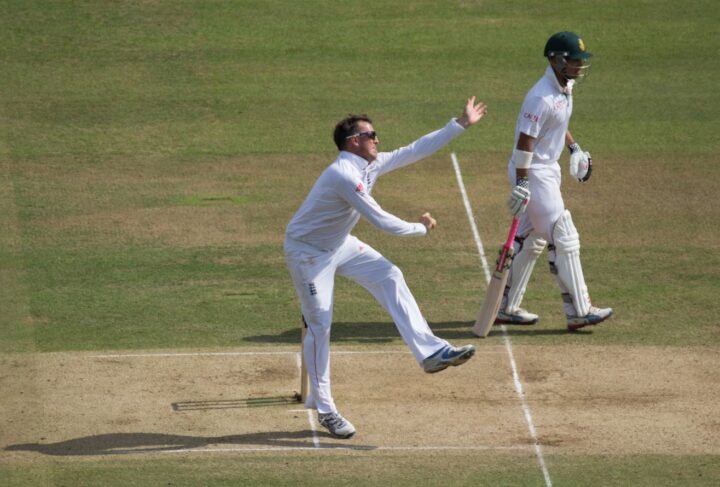Today Geoffrey Bunting looks at England’s dreadful treatment of specialist spinners. Is it a failure to appreciate the art, a failure to recognise that development takes time, or simply a failure to value specialist cricketers in general?
Summer 2019. Everything’s coming up Jack Leach. At the beginning of the season, he dug England out of a hole against Ireland with the bat. He does it again against Australia at Headingley – albeit with a little help from Ben Stokes. Leach’s teammates laugh as they film him reliving his lone single. He scampers between the wickets in the gloom, the clink of beer bottles echoing around the empty ground. In a series dominated by pace, Leach takes twelve wickets at 25.83. He feels invincible.
Heading to New Zealand, Leach has supplanted Moeen Ali as England’s first-choice spinner. It’s been a long road. He battles chronic illness, a surprise remodel of his action, and has watched England pick everyone but him. Some claim he’s had it easy at Taunton. But all that matters is that he’s here on the plane, he’s taking wickets – he’s pretty good.
When he leaves Bay Oval on the 25th November, the heady sensations of Headingley are long-forgotten. BJ Watling and Mitchell Santner have ground England to dust. The bowling was limp and tired, and now pundits want a scapegoat.
Rob Key leads questions over whether Leach has developed at all. Bowling on a dead pitch on days two and three, his lack of penetration is apparently a major concern. Allegedly, Jack Leach isn’t winning games for England. Never mind his performances before this test. Forget that the whole bowling group failed to break Watling and Santner’s partnership. Don’t mention that, with wickets in hand, England failed to bat out the last day. Ignore that the Bay Oval has never hosted a test before; that there’s no metric of performance here. Somehow this is Jack Leach’s fault.
He hasn’t played for England since
Have you heard the one about the guy who invented the revolving door?
Since Graeme Swann’s retirement in 2013, England have employed twelve spinners. Of those twelve seven made their debut, three have only played one test, two were batsmen (and one became a batsman after his experience), and two were Gareth Batty and Samit Patel. Indeed, five were selected on a single tour.
After years of cycling through options, Jack Leach’s twenty-one wickets in Sri Lanka at 21.38 should have been a revelation. Two years later, he’s out of the side with England preferring a go on the Generation Game conveyor belt. The selection of Bess was mostly based on potential and though his second attempt at test cricket saw him vastly improved there is a perception his batting and fielding are more important to the selectors. That his energy can often be mistaken for a young Joe Root can’t hurt.

The way England have selected specialists – and spin in particular – in the last few years has been instructive of a shift in their attitudes. Under Duncan Fletcher, specialists were asked to improve their other skills. Batsmen were encouraged to bowl a little, bowlers told to field and get better with the bat. But specialists they remained. Now, specialism only appears valuable to the ECB if accompanied by something else. Even if that something else comes at the expense of the original skill. When Moeen Ali was selected in 2014, it wasn’t because he was the best spinner in the country. Rather, he was a talented batsman and part-time bowler. Samit Patel was even more of a part-timer. Zafar Ansari, Scott Borthwick, and Liam Dawson were all viewed as all-rounders. With all this in mind, Ollie Rayner’s droll advice to young spinners feels especially pertinent under this regime: “learn to bat.”
With selection even in the County Championship proving difficult “spinners… have resorted… to improving their batting and fielding to force their way into teams at No.8.” Those that haven’t, including the most recent sacrifices to England’s obsession with legspin, are struggling for game time. “Unless you are a genius like Saeed Ajmal or Muttiah Muralitharan or Shane Warne,” Rayner says. “Your path won’t be straightforward.” Despite evidence that spinners don’t reach their prime until later, England “selectors still seem intent on pushing the claims of youngsters right at the start of their careers.”
Swann, himself, spent almost a decade playing first-class cricket before emerging as England’s best spinner. Selecting young spin-bowlers isn’t necessarily a bad thing. Nor, in an age of often intense coaching, is it necessarily a negative to allow them to “watch and experiment”; to give them some room for their own development. But England’s habit of chewing up young spinners and discarding them without further thought suggest a lack of interest in the development of spin-bowlers of international quality. And while competition, for what is often one spot, should be fierce – it shouldn’t ruin careers.
Simon Kerrigan was 24 when he was picked against Australia. He returned figures of 0-52 from eight overs in the match and was never the same. At the time of writing, he has signed for Northamptonshire after not playing a professional game for three years. Scott Borthwick fared slightly better when thrown into the disastrous 2013/14 Ashes. Now he’s a batsman and hasn’t added to his single cap. Liam Dawson impressed with his control in India. He played two more tests at home to offset Moeen Ali’s chronic lack of self-belief before he, too, was discarded. Zafar Ansari was a strange selection in the first place to tour the UAE and India – though no stranger than 39-year-old Gareth Batty – and promptly left the game after returning home. Even Moeen, England’s most-capped and most successful spinner of late, and his ongoing slump suggest a lack of comfort within the set-up. The list grows uncomfortably long.
And while the marginalisation of spinners is somewhat offset by the fact that test cricket in the last five years has been dominated by quick bowlers. It doesn’t excuse England’s cluelessness when it comes to picking spinners or their treatment when, brought into a system that has no respect for them, they fail to prosper – or, in the case of Jack Leach, do.
There is an impression that whatever England don’t understand – be it spin-bowling, keeping, fast-bowling or opening the batting – doesn’t interest them. Concerns over Archer and Wood are dismissed despite the precedent the ECB have set with former fast bowlers. All while they persist in turning to a specific set of players – players they particularly like – and shoehorning them into specialist roles for which they’re underqualified. It wasn’t too long ago that England, following Alistair Cook’s retirement, refused to select specialist openers. Remember, also, that fast-bowlers existed in 2017 but England elected to take Jake Ball and Tom Curran to Australia. Young spinners were on the circuit when Moeen Ali was declared England’s first-choice spinner. While Many keepers have been working hard in the county game while England have indulged – and continue to indulge – the whims of Jonny Bairstow.
A question of value
I have worked as a book designer for almost ten years. Competition is fierce. Not from other professionals but from jobbing amateurs and DIY daredevils. On a daily basis I field queries from clients who offer £100 for a book cover, independent businesses who have £50 to put toward a corporate identity – and that’s if they’re willing to pay at all. The message is clear: we don’t value what you do. Young designers and graduates are being driven from the industry at an alarming rate, unable to compete with amateurs who offer dirt-cheap, low-quality work and call it “professional.”
Consider, then, the message England sends when they select the same underperforming batsmen, misuse their fast-bowlers, and ruin spinners’ careers. Ask yourself: is Dom Bess the best spinner in the country or does he just fit into a certain mould that England prefer? Is Moeen the best spinner in England, was he when first selected, or do England just like his batting? Imagine how it feels as a young spinner to see a batsman selected ahead of them; watching as England put more time into Moeen Ali than they ever have in the general development of spin.

There appears to be a tacit understanding at the ECB of how to manage and utilise fast-medium bowling. The same is true, to a point, of batsmen (though ask yourself why so many discarded batsmen don’t appear for the Lions). Time and energy will be put into their success and failure. This, naturally, encourages growth at the game’s top levels. Sam Curran is currently the beneficiary of such a system. England like Sam Curran. He embodies their favourite things: batting and medium-pace. It sees him regularly picked ahead of better bowlers and the result is that he is constantly improving.
The idea of nurturing a utility player like Curran comes naturally to the ECB. Doing the same for a spinner does not. England often make the right moves with spin camps or Lions trips to Asia, but when it comes to following-through they’d rather pick Sam Curran. His consistent development shows England what might happen if, say, they stuck with a spinner for longer than two series but it’s a lesson England refuse to learn. One has to wonder what might have happened if Curran had not had an immediate effect in international cricket. Would he still be part of the test set-up or, like so many other young players – including his brother – might he have been sent back to county cricket with little hope of a recall?
So why would a young English spinner look at international cricket and not – like Borthwick – turn to batting or – like Ansari – look for better prospects elsewhere? It’s that great and unnecessary conundrum that plagues entry-level jobs: how can one apply experience to a role if you’re actively barred from gaining experience by the need for experience? How can English players be criticised for a lack of development if the set-up actively removes opportunities to develop? Given that England were keen to pick Keaton Jennings for Sri Lanka – likely taking an opportunity to improve in Asia from either Burns or Sibley – it appears to be a paradox the ECB are unwilling to address.
Consider for a moment the cost of developing a cricketer. Not the abstract value, but the quantifiable economical price of making a first-class cricketer. There is an astronomical cost to trying to find the next Joe Root or James Anderson. The success rate is pitifully low – that is the nature of top-level sport. But England, in particular, have a pathetic conversion rate from good to great players. One can bemoan the lack of quality in County Cricket, but such a poor record of producing genuinely world-class players suggests major issues throughout the set-up.
Which is not to say Jack Leach is a great player. Rather, if the best spinner in the country doesn’t play how will we know the level they might reach? How can Jack Leach overcome the criticism levelled at him if he only plays in India? You cannot predict what players will become so early in their careers. No one looked at Joe Root in his first test and guessed, almost a decade later, that his record would resemble Stephen Fleming more than Sachin Tendulkar.
Returning to Rayner’s point that “unless you are a [spinning] genius” you’re in for a rough ride. Even those we regard as geniuses of the art, Warne and Muralitharan in particular, weren’t at their peak from the start. The hard work they put in was coupled with faith from their selectors. Had Warne been judged with England’s ostensible current criteria, he likely only would have played one test match. But if Jack Leach has been branded not good enough after a single, collective, poor performance or Ben Foakes because England really like Jonny Bairstow, what hope do young players coming through have?
At times, England resemble a dysfunctional ex-boyfriend. Unable to move on from old flames, if a new partner isn’t exactly right immediately, they’d rather just text their ex. One bad test and Jack Leach is on the sidelines, one bad summer and Bess is being replaced by Moeen Ali? If spinners don’t immediately succeed, Adil Rashid is likely to receive a text asking, “u up?” Current attitudes suggest that England will never find a spinner to stick with, so invested are they in a small crop of favoured players and ejecting all those that don’t fit into that pattern – to the tune of twelve spinners in seven years.
Geoffrey Bunting









“Zafar Ansari was a strange selection in the first place to tour the UAE and India”.
It’s even worse than that because they almost certainly would have picked Ansari for the preceding tour to Asia but he was unavailable through injury.
Overall, I’m glad the writer hasn’t fallen for the mistaken idea (usually justified by reference to Swann) that spinners are best left for selection until they’re older. Young spinners like Saqlain and Vettori have been highly successful. Underwood and Emburey were picked young – and the latter declined markedly as he aged.
However there are several parts of the jigsaw missed out. One is obviously the CC schedule. How are spinners going to develop when there’s virtually no f/c cricket played June-August? The answer is they aren’t and the ECB don’t care because all they care about is the kerching from their franchise model. The other is that Test cricket has been blatantly gerrymandered in the last 4 or so years to produce short games and introduce de facto shortened Tests (in lieu of the open introduction of 4 day Tests which would provoke too much opposition). When the ball swings and seams around corners who needs spinners (or specialist keepers or batsmen who can do anything other than carve a quick 50?).
Not sure I understand the point about Ansari–the Asian tour preceding the UAE series was India in 2012, when Ansari was still 20 and completely unproven in county cricket…and when he wouldn’t have had a hope in hell of supplanting Swann and Panesar.
I recall that Ansari fell over the boundary a few days after being announced. Though, I think at that point he was very much a third spinner pick – which is too many, anyway – with a view of giving him some experience around the group. I’m not sure he would have ever been pushing for selection at that point, with Swann, Panesar, and Tredwell in the squad – was Samit added after Ansari’s injury? I don’t recall. But it wasn’t unusual for England to select potential spinners to just hang out and feed the more experienced players grapes and stuff.
In Bangladesh and India in 16/17, it really felt like he was chosen as a third spinner to be selected alongside Rashid and Moeen. Despite not really having any form. Again, not as weird as England picking Batty as player/coach while Saqlain was around. One feels they felt like the tests against Bangladesh were a bit of a warm-up only to then be rolled over in the 2nd test but better spinners.
My prevailing memory of that tour is Moeen and Rashid collectively going at five-an-over to Karun Nair, a player who is probably part of India’s D-team.
Samit was added to the squad in 2015 after Ansari’s injury, but not in 2012–he was an original pick then (but Tredwell wasn’t: I don’t think he went on a test tour after 2010 other than the WI tour in 2015).
Didn’t Ansari also get injured in 2016? I was trying to remember who Dawson came in for, and I’m pretty dure it wasn’t Batty.
It’s worth asking: how would England have nurtured Nathan Lyon? Yes, he came at the end of a long merry-go-round himself, but look at the support he got in his first couple of years in Test cricket. He was consistently picked. The exceptions to this state of affairs – India and England in 2013 – only lasted a couple of Tests before he was returned to the team.
Considering how England have handled Jack Leach, who at least held his own by comparison with Lyon, it’s hard to see how Lyon would have avoided being discarded at the first sign of trouble.
Good point! Leach out bowled Lyon in the Ashes last year. I imagine Lyon might have got a look in at some point but he probably would’ve had the same issues with the selectors and management. He can’t bat and, as we saw at Headingley, he’s not the world’s greatest fielder either.
I think it’s also worth considering how spinners fit into a team. Ashley Giles didn’t have an impressive record but was valuable as a foil to the aggressive quicks Vaughan had at his disposal, similarly the attacking – though also economical – bowling of Swann fit perfectly in Strauss’ dry bowling attack; though Broad would often go for runs, convinced that he wanted to bowl short.
Now, that kind of thing doesn’t appear to be a consideration. For a long time, pundits would say “England need someone to hold down an end” when watching Moeen go at fours. But the consideration in selection and in the dressing room appears to be more along the lines of “what else can they offer?”
But there does also appear to be a personal element. Leach can bat and he can field. He may not be as high-energy as Bess but he’s certainly not so behind that the package of Bess is so different to Leach. I imagine the set-up would say that Bess “has something about him” which tends to mean he’s more aligned with Joe Root than other players (remembering that Buttler, Woakes – who is often under-bowled by Root – and Leach are very good friends). There does appear to be a certain clique-ish nature to England, if only in selection.
I’m not very convinced by the Lyon comparison. Lyon pretty much WAS dropped at the first sign of trouble–and he was left out for four tests out of five for Xavier Doherty (what were they thinking?!) and Ashton Agar, whose contemporary English equivalents are probably Danny Briggs and Hamiullah Qadri, neither of whom are anywhere near the test team. I suspect that fact that his confidence didn’t take a big hit from that owes quite a bit to luck.
Your point about how bowling attacks fit together is a good one I think, Geoffrey. My feeling with Ali–especially having picked him knowing that he hadn’t been a front-line spinner up to that point–was that the management’s mistake was in dogmatically identifying the spinner as the person who had to hold down an end. If you have an attacking spinner with a very low strike-rate, there’s no need for that to be true–and it’s an argument that’s rarely applied to fast bowlers (who heard Mark Wood being described like that at the same time?)
Bowlers with low strike rates who pick up plenty of wickets need to be worked round to my mind–that was how England destroyed Steven Finn’s international career. At that stage in his career, Anderson was playing that role anyway, Woakes could have done it in England and Leach in Asia where they would have played two spinners.
Incidentally, it’s interesting that of your 12-spinners-since-Swann, only one has been given a debut by Smith–and that was in a form and injury crisis in Smith’s first match. In the subsequent three years, he hasn’t given any. This rather underlines for me that Leach was treated worst before he was selected rather than afterwards–he should have been in the side for the India tour and for the 2017 Ashes.
There’s a clear rationale to most of his absences since then, even the start of last summer (the management seemed to be worried that he hadn’t fully recovered from a life-threatening illness). Although there were whinges after the NZ test, he wasn’t picked because he was ill rather than dropped. Interesting too that Smith seems to be happy to pick Leach, which suggests to me too that it’s mainly the team management who want Bess.
I like your point about Fletcher’s attitude to multi-skilling specialist players, too. It–not for the first time–makes me wonder exactly what Graham Thorpe is bringing to the team as batting coach….if indeed he is, which seems shrouded in mystery and which isn’t a good sign in itself.
I concur wholeheartedly with this. I’ve been baffled by the ejection of Leach (and Foakes, who I suspect will be carrying the drinks in spite of his Boy’s Own entry into Test cricket).Even when he’s not taking wickets, Jack can accurately hold up an end for the seamers and as we’ve seen, he’s a dogged batsman with the right attitude. Unlike many, I have a lot of time for Graeme Swann and whatever you think of him, I really can’t understand why the ECB haven’t tapped the resource of his knowledge and skills for coaching – he said himself he would have jumped at the chance. I guess that would be another example of face-fits. Do England even have a specialist spin coach?
I don’t think Swann is a case of face not fitting–unless people who often come across as self-obsessed, arrogant bullies who aren’t very good team players magically have a non-fitting face!
That’s particularly true in coaching, where there’s much more emphasis on conveying your message and being a good people person than on your own cricketing talent.
I didn’T see the game today, but the view is that both Leach & Bess didn’t bowl very well. Let’S see how they perform tomorrow.